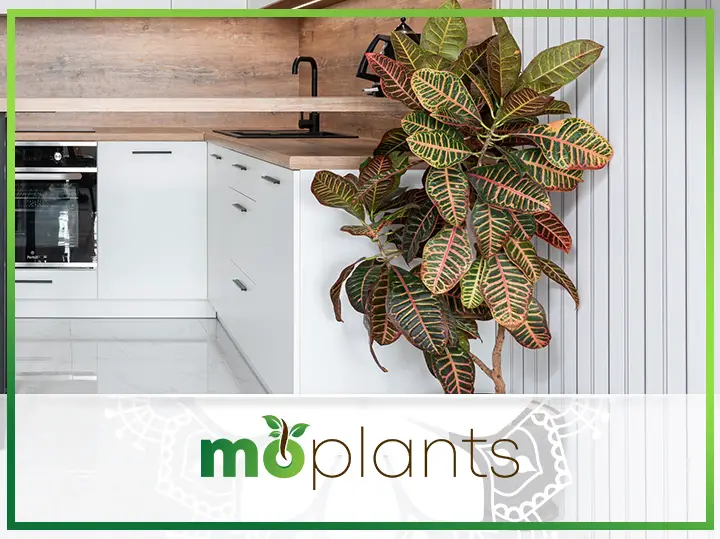The bright and glossy foliage of the croton plant makes it the epitome of tropical beauty. This trendy houseplant is known for its ornamental appearance that can brighten up any dull corner of your home. You can place it on the windowsill in your bedroom or display it on a sunny spot in your living room to add some freshness to your space.
Though this multicolored plant is native to Indonesia, Malaysia, and the western Pacific Ocean islands, it can grow in any tropical region with warm weather and high humidity. If you live in a relatively colder area, you can care for a croton plant indoors by placing it in a warm location next to a humidifier.
The bold colors of croton plants have earned them the reputation of being dramatic and high-maintenance. While it’s true that these charming houseplants take some time to adapt to their new climate, they are not nearly as fussy as people believe them to be. If anything, crotons can thrive despite minimal care.
Here is everything you must know about how to grow and care for a croton plant indoors.
Introduction: Croton Plant
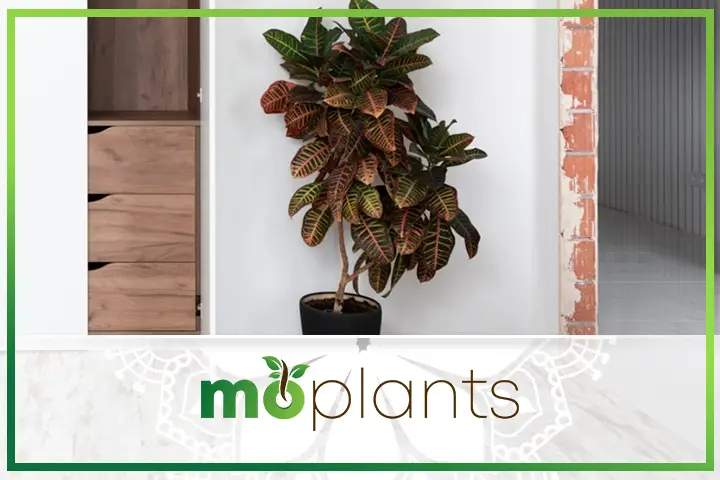
The botanical name of the croton plant is Codiaeum variegatum, though it is commonly called Variegated Laurel.It belongs to the genus Codiaeum in the Euphorbiaceae family and is classified as an evergreen shrub. You can find hundreds of croton plant varieties worldwide, each boasting its distinctive shape, color, and care preferences.
In their native habitat, crotons can grow between 10 to 20 feet. However, in an average home environment, these spectacular plants top out at 3 to 8 feet. If you live in USDA zones 11 and 12, you can easily grow these plants outdoors to add some curb appeal to your home. However, these houseplants also flourish indoors.
The vivid hues of crotons range from green, yellow, red, orange, bronze, purple, and pink to a combination of these colors. If you look hard enough, you may even find cream, black, and variegated varieties to complement your home décor. In addition, some croton plant varieties may change their color or turn darker as they mature.
It is also worth mentioning that each croton plant is unique. Some rare varieties are highly sought after by collectors and enthusiastic gardeners, adding to the popularity of this eye-catching houseplant. Nonetheless, if you want to distinguish a croton plant from another, please note that experts typically subdivide them according to their foliage. For example, some crotons feature curling leaves, while others may have twisted, long, short, narrow, broad, or oval leaves.
Furthermore, the croton leaves are usually coarse, dense, and thick with a leathery texture. Also, they have an average size of four to six inches. Since these plants grow relatively slowly, you can expect them to gain under 12 inches of height every growing season.
You may also find it interesting that these exotic plants are pretty resilient and difficult to kill – provided you don’t overwater or expose them to harsh sunlight for a prolonged period. Additionally, they are not fond of being moved from one place to another. However, they are pretty easy to grow once they get acclimated to their new home.
How to Grow Croton Plants
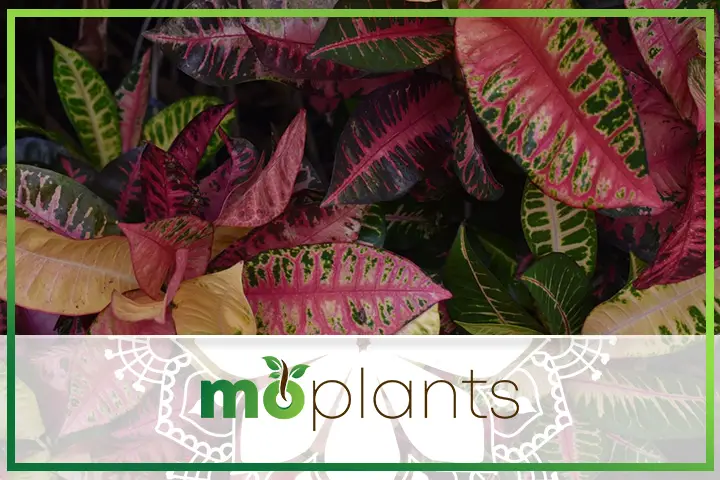
Let’s look at some tips on growing croton plants indoors.
Placement
If you want to keep this bold and colorful plant happy, place it in front of the east, north, or west-facing window in your home. When putting it near a south-facing window, make sure to position the plant at least six feet away to protect the foliage from getting burned.
Since crotons love sunny locations, you can even place your plants on your patio or terrace during the summer months. However, make sure to bring them indoors as soon as the weather begins to get cold.
Ideal Temperature
Croton is a tropical plant, which means it prefers warm weather.
This stunning houseplant thrives in temperatures between 60 degrees and 70 degrees Fahrenheit. If you have placed your croton outdoors, you may want to move it back inside once the temperature drops below 55 degrees Fahrenheit. Moreover, these plants also don’t do well in extreme heat. Their leaves may begin to turn brown if the temperature exceeds 80 degrees Fahrenheit.
Humidity Level
It would be best if you considered putting your croton in a room with high humidity, such as a bathroom. These plants flourish and remain healthy in homes with humidity levels between 40% and 80%.
However, if you live in a relatively dry region, you can replicate the humid environment of tropical forests by placing the plant on a pebble tray filled with water. As the moisture evaporates, it will create artificial humidity for your croton. Alternatively, you can invest in a small humidifier. Misting the plant can also help keep the leaves bright and vibrant.
Exposure to Sunlight
As mentioned above, croton plants need the sun to survive. On average, your plants must receive about six to eight hours of direct sunlight every day. You can place them on a window sill or near a doorway that gets a ton of natural light throughout the day.
It is also pertinent to mention that some croton species require bright but indirect light, while others prefer partial shade. Typically, the plants with variegated and multicolored foliage need more sunlight than the rest. However, please make sure your houseplant doesn’t receive intense sunlight for prolonged hours, as it may burn the leaves.
Watering Frequency
Croton plants prefer moist soil, but that doesn’t mean you should overwater or keep the soil wet at all times.
The correct way to determine if your plant needs water is to check the soil. If the top of the potting mix feels dry, you may water it thoroughly. Meanwhile, if the soil feels moist, wait for a couple of days to prevent overwatering.
Depending on the temperature and humidity in the room, some croton plants may require daily watering, while others may need it once a week. Regardless of which type of croton you are growing, please ensure the soil doesn’t stay dry for long periods.
During the summer months, mist the plant every day to keep it evenly moist. In the winter season, cut back on watering to prevent root rot, which may eventually kill your croton plant.
Potting Mix
If you are planning to grow a croton plant indoors, select a well-drained potting medium with neutral pH.
You can either buy a unique mix from your local nursery or create your own by combining regular soil and peat moss with perlite. This type of potting mix will drain excess water while retaining sufficient moisture to keep the humidity-loving plant from drying out. Additionally, you can use a mulch to keep the plant hydrated while reducing weed growth.
Infographic
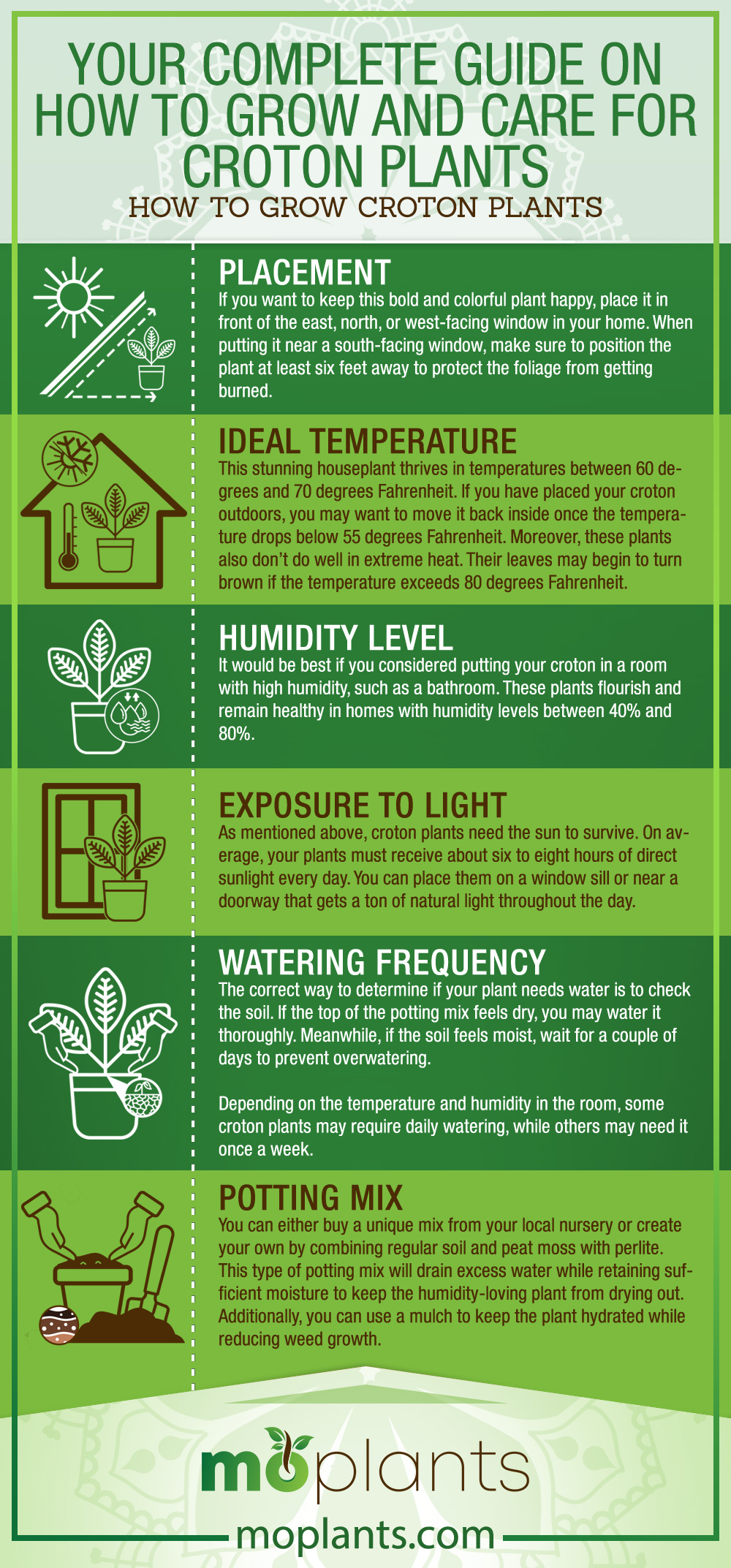
Croton Plant Propagation Method
The easiest and most efficient way to propagate the croton plant is through its cuttings.
Once the tropical plant grows about three feet tall, you can use a clean and sterile knife to separate a four to six-inch cutting from the foliage. Make sure to cut below the growth nodule and remove all about four to five leaves at the top. You can dip the end of the cutting into a rooting hormone or powdered charcoal before laying it on a piece of paper. This practice will allow the sap to dry.
Later, plant the cutting in fresh soil and add some water to the pot. You can also cover it with a loosely tied plastic bag to provide the plantlet with a humid environment. Place the cutting in a warm location and keep the soil evenly moist until the baby plant begins sprouting new roots.
This croton plant propagation method can take up to a month or more, depending on the variety you have chosen to propagate.
Croton Plant Care Tips
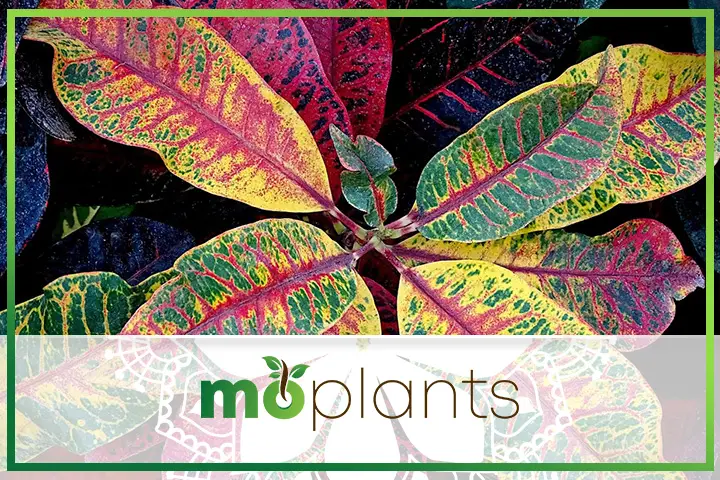
Now that we know about the croton plant propagation technique, it’s time to discuss ways to look after this striking beauty.
Pruning and Trimming
While it’s true that strategic pruning can encourage bushy growth, you should be careful not to overdo it.
Ideally, it would help if you only pruned your crotons to remove dead leaves and branches. It will promote new growth and encourage the better distribution of nutrients.
Trimming overgrown leaves and stems may also be a good idea if you want your plant to retain a particular shape. Nonetheless, always cut the foliage just about the node-set. Moreover, refrain from removing more than one-third of the stem at one time as it may shock the plant.
Cleaning the Plant
The gorgeous foliage of croton plants attracts tons of dust and debris. So, if you want your plant to remain lustrous at all times, mist the leaves and gently wipe them with a soft cloth. You can do this twice a month to keep the plant clean and beautiful.
This is also one of the top croton plant care tips to deter pest infestation. Additionally, it will protect your plant from acquiring other diseases.
Fertilizer
Crotons are heavy feeders. These broadleaf evergreens love organic matter and look their best when they receive regular applications of low-nitrogen and slow-release fertilizers. Make sure to follow the manufacturer’s instructions to apply the correct amount.
Like most tropical plants, crotons will appreciate it if you feed them during the growing season. If you use organic fertilizer, a single application in summer and spring will be sufficient for the houseplant. Please do not feed your croton during the dormant season, as it may result in plant burn.
Repotting
Excessive repotting can stress out your croton plant. During the first three years, you can repot this plant every 12 months. However, as it matures, you should only replant it if you believe it has become root-bound.
If your plant has outgrown its container, gently remove it from the pot along with its root ball and transfer it into another container that is a size larger than the previous one. Next, fill the pot with fresh potting soil and water the plant if needed.
Choosing the Right Container
Our last croton plant care tip is choosing the correct container. You can select either terracotta or plastic pots to grow your croton plant. If you choose the first option, you may have to water your plant often, as terracotta pots can absorb moisture from the soil. Nonetheless, regardless of which material you select, please ensure the pot has an adequate drainage hole at the bottom.
Are Croton Plants Toxic?
Croton plants are toxic for humans, dogs, and cats. Their stem and leaves contain a poisonous sap that can irritate your skin if you touch it. In some cases, it may even cause contact dermatitis, a type of skin rash.
Meanwhile, ingesting the plant can lead to accidental poisoning. Since crotons taste terrible, the chances of your toddler or pet consuming a large quantity of its sap are very low. However, to ensure the safety of your kids and furry companions, keep this aesthetically pleasing plant out of their reach.
Common Signs of Croton Plant Poisoning
Here are some of the most common symptoms that may occur in pets after ingesting the croton plant.
If your pet is exhibiting any of these symptoms, be sure to immediately get in touch with a vet. On the other hand, if you suspect your child has ingested a part of the croton plant, they may require prompt medical attention. Therefore, you should take them to the nearest ER.
Common Croton Plant Problems and How to Solve Them
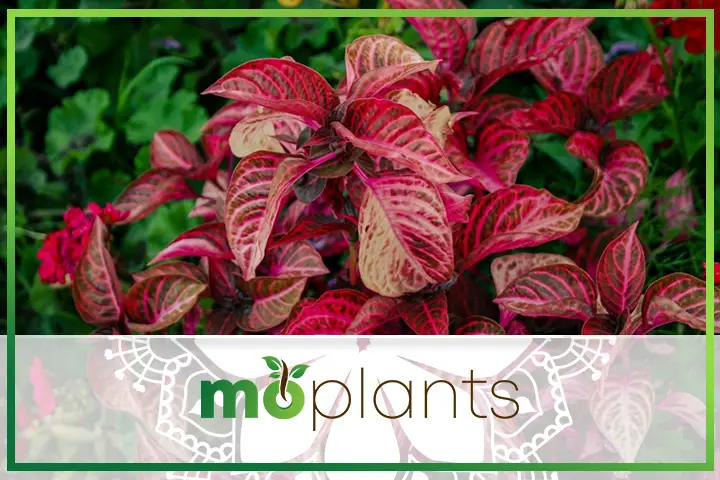
Here are some of the most common issues you may encounter while growing croton plants in your home. To help you out, we have also provided antidotes to each of these problems.
Loss of Color
Are the leaves of your croton plant losing their color or look extremely pale? If that’s the case, you may want to move your plant to a brighter location.
Most plants experience loss of color if they don’t receive sufficient sunlight. Therefore, moving your plant outdoors or keeping it under the direct sun may help restore its brilliant hue.
Brown Leaves
If the leaves of your croton plant are turning brown and crispy, it probably means the foliage is receiving a lot more sun than it needs.
Since they belong to a tropical climate, these plants need direct sunlight to thrive. However, exposing them to harsh sunlight for long periods can be detrimental to their health. To counter this problem, move your plant to a better location and mist it every day.
Wilting Plant
Wilting leaves are the most significant indication that your plant is dehydrated. This usually happens during the summer, when the soil dries out relatively quickly, resulting in wilted foliage.
To solve this problem, water your plant thoroughly and then wait for the potting mix to dry before watering it again. Be careful not to overwater your croton, as excessive moisture can be fatal to this exotic beauty.
Common Pests and Diseases
Croton plants are usually disease-free, but they may become susceptible to spider mites, mealybugs, scales, and thrips, among other common pests. If you notice bugs on the foliage or the stem, consider cleaning the plant with a cotton ball soaked in rubbing alcohol.
Infographic
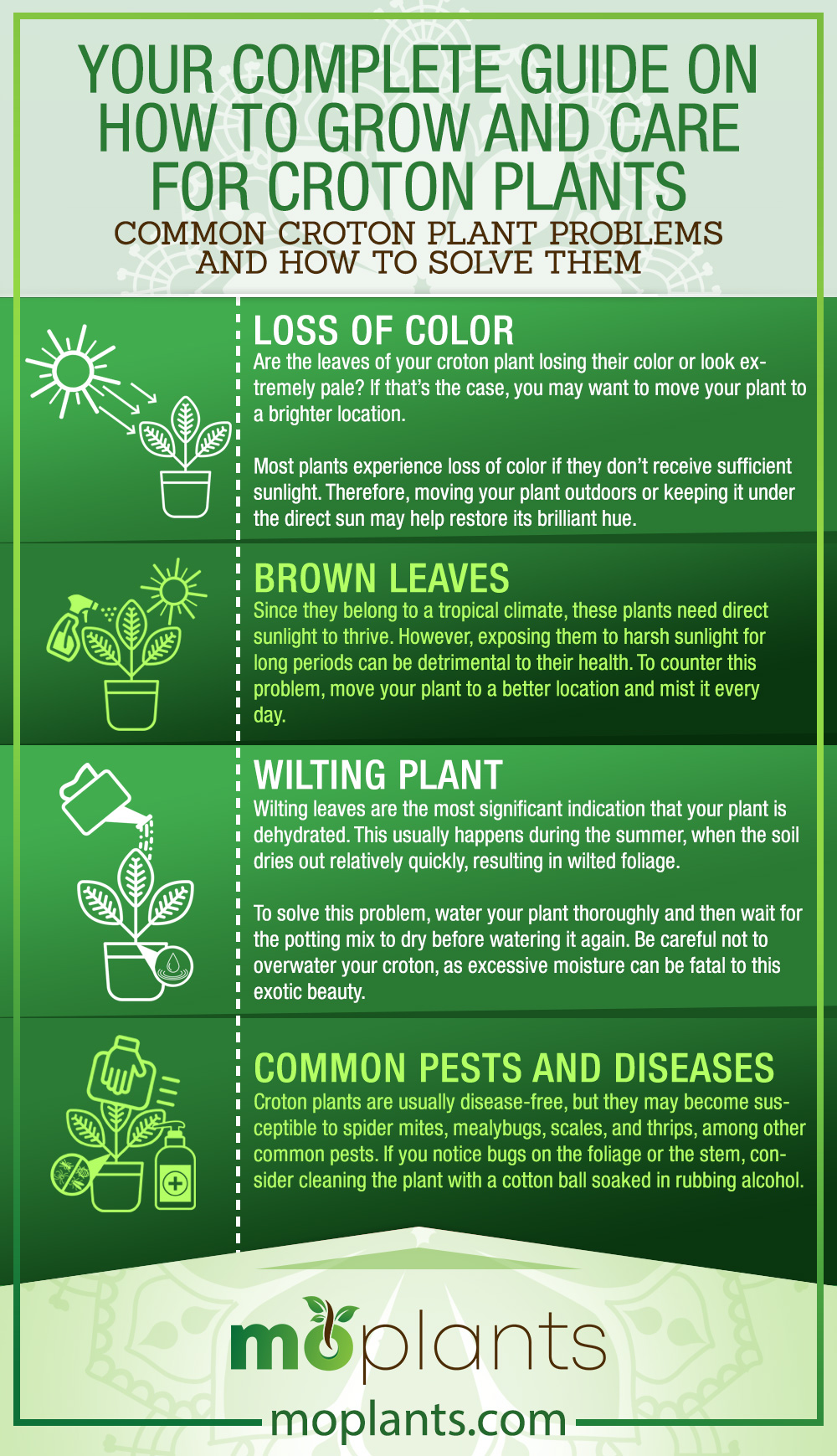
Popular Croton Plant Varieties
These are some of the most revered croton plant varieties that can instantly elevate your interior design.
Codiaeum Variegatum ‘Gold Dust’
The ‘Gold Dust’ variety of croton is known for its dark green leaves sprinkled with golden-yellow spots. These houseplants are low-maintenance and can grow as tall as six feet in an average home environment.
If you want to add a touch of luxury and extravagance to your home décor, Codiaeum Variegatum’ Gold Dust’ is perhaps your best option.
Codiaeum Variegatum ‘Petra’
Native to Southeast Asia, the ‘Petra’ variety of croton plants features burgundy, bronze, red, orange, or green foliage. It is a slow-growing plant that can reach the height of five feet when grown indoors.
Moreover, these plants prefer high temperatures ranging between 60 and 85 degrees Fahrenheit. You can also place them outdoors in large containers to ensure healthy growth.
Codiaeum Variegatum ‘Zanzibar’
The unique narrow leaves of Codiaeum Variegatum’ Zanzibar’ make this plant stand out from the rest. Its distinctive foliage boasts yellow, orange, green, purple, or red colors, adding to its aesthetic appeal. In addition, these plants can grow up to six feet tall, and they flourish in bright sunlight.
This croton variety is native to Western Pacific Islands, Australia, and tropical Asia.
Croton Plant FAQs
Let’s look at some of the most frequently asked questions about croton plants.
Do croton plants grow fast?
Compared to other tropical plants, croton can be classified as slow growers. They usually grow less than 12 inches each growing season.
How to keep crotons colorful?
Your croton plants will remain beautiful and vibrant as long as they receive adequate sunlight and proper nutrition. Therefore, don’t forget to feed your houseplant during the growing season and keep it in a sunny location.
Do crotons clean the air?
Though they are celebrated for their stunning foliage, croton plants are also fantastic at cleaning indoor air. They can absorb harmful toxins from their surroundings, thus improving the indoor environment.
Does the foliage of croton plants change color?
Most croton plant varieties tend to change their color from green to yellow as they grow. Mature leaves are likely to have bolder hues than the younger ones. These shades may also get darker as the season progresses.
To conclude, crotons are one of the best plants to grow indoors. They are charming, attractive, and, most importantly, easy to grow. They don’t require constant attention and grow well on their own as long as you keep them in a sunny location and water them regularly.

